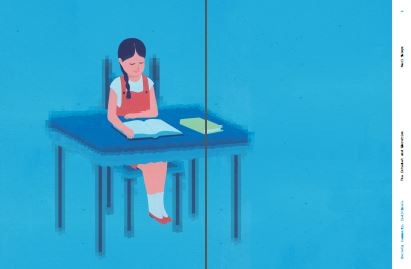The Internet and Education |
 |
 Diese Seite wurde seit 9 Jahren inhaltlich nicht mehr aktualisiert. Unter Umständen ist sie nicht mehr aktuell.
Diese Seite wurde seit 9 Jahren inhaltlich nicht mehr aktualisiert. Unter Umständen ist sie nicht mehr aktuell. Zusammenfassungen
Zusammenfassungen
 In many ways, it is difficult to discuss any aspect of contemporary society
without considering the Internet. Many people’s lives are saturated so
thoroughly with digital technology that the once obvious distinction between
either being online or offline now fails to do justice to a situation
where the Internet is implicitly always on. Indeed, it is often observed that
younger generations are unable to talk about the Internet as a discrete entity.
Instead, online practices have been part of young people’s lives since
birth and, much like oxygen, water, or electricity, are assumed to be a basic
condition of modern life. As Donald Tapscott (2009, 20) put it, “to them,
technology is like the air.” Thus, in many ways, talking about the Internet
and education simply means talking about contemporary education. The
Internet is already an integral element of education in (over)developed nations,
and we can be certain that its worldwide educational significance
will continue to increase throughout this decade.
In many ways, it is difficult to discuss any aspect of contemporary society
without considering the Internet. Many people’s lives are saturated so
thoroughly with digital technology that the once obvious distinction between
either being online or offline now fails to do justice to a situation
where the Internet is implicitly always on. Indeed, it is often observed that
younger generations are unable to talk about the Internet as a discrete entity.
Instead, online practices have been part of young people’s lives since
birth and, much like oxygen, water, or electricity, are assumed to be a basic
condition of modern life. As Donald Tapscott (2009, 20) put it, “to them,
technology is like the air.” Thus, in many ways, talking about the Internet
and education simply means talking about contemporary education. The
Internet is already an integral element of education in (over)developed nations,
and we can be certain that its worldwide educational significance
will continue to increase throughout this decade.That said, the educational impact of the Internet is not straightforward. At a rudimentary level, it is important to remember that well over half the world’s population has no direct experience of using the Internet at all. While this is likely to change with the global expansion of mobile telephony, the issue of unequal access to the most enabling and empowering forms of Internet use remains a major concern. Moreover—as the continued dominance of traditional forms of classroom instruction and paper-and-pencil examinations suggest—the educational changes being experienced in the Internet age are complex and often compromised. In addressing the topic of “the Internet and education” we therefore need to proceed with caution. As such, this chapter will consider the following questions:
- What are the potential implications of the Internet for education and learning?
- What dominant forms of Internet-based education have emerged over the past 20 years?
- How does the educational potential of the Internet relate to the realities of its use?
- Most importantly, how should we understand the potential gains and losses of what is being advanced?
 Dieses Kapitel erwähnt ...
Dieses Kapitel erwähnt ...
 Personen KB IB clear | Sonja Baumer, Matteo Bittanti, danah boyd, John Seely Brown, Rachel Cody, Allan Collins, Larry Cuban, Richard Halverson, Becky Herr-Stephenson, Heather Horst, Mizuko Ito, Patricia G. Lange, Rose Luckin, Dilan Mahendran, Katynka Z. Martínez, C.J. Pascoe, Dan Perkel, Laura Robinson, Christo Sims, Don Tapscott, Douglas Thomas, Lisa Tripp, David Tyack | |||||||||||||||||||||||||||||||||||||||||||||||||||||||||||||||||||||||||||||||||
 Aussagen KB IB clear | Leitmedienwechsel-Reaktion 5: Wer redet noch von Schule? | |||||||||||||||||||||||||||||||||||||||||||||||||||||||||||||||||||||||||||||||||
 Begriffe KB IB clear |  Apple, Apple,  Computer Computer computer, Coursera, computer, Coursera,  Digitalisierung, edX, flipped classroomflipped classroom, Digitalisierung, edX, flipped classroomflipped classroom,  Internet Internet internet, internet,  Lernen Lernen learning, MOOCMassive Open Online Course, learning, MOOCMassive Open Online Course,  Open Educational Resources (OER) Open Educational Resources (OER) Open Educational Resources, Open Educational Resources,  Schule Schule school, Success to the SuccessfulSuccess to the Successful, school, Success to the SuccessfulSuccess to the Successful,  Video Video video, Wikiwiki, video, Wikiwiki,  Wikipedia, Wikipedia,  YouTube YouTube | |||||||||||||||||||||||||||||||||||||||||||||||||||||||||||||||||||||||||||||||||
 Bücher |
|
 Dieses Kapitel erwähnt vermutlich nicht ...
Dieses Kapitel erwähnt vermutlich nicht ... 
 Nicht erwähnte Begriffe | Bildung, Kinder, LehrerIn, Udacity, Unterricht, Wiki in education |
 Tagcloud
Tagcloud
 Zitationsgraph
Zitationsgraph
 Volltext dieses Dokuments
Volltext dieses Dokuments
 |  The Internet and Education: Artikel als Volltext ( The Internet and Education: Artikel als Volltext ( : :  , 1750 kByte; , 1750 kByte;  : :  2021-03-21) 2021-03-21) |
 Anderswo suchen
Anderswo suchen 
 Beat und dieses Kapitel
Beat und dieses Kapitel
Beat hat Dieses Kapitel während seiner Zeit am Institut für Medien und Schule (IMS) ins Biblionetz aufgenommen. Beat besitzt kein physisches, aber ein digitales Exemplar. Eine digitale Version ist auf dem Internet verfügbar (s.o.). Es gibt bisher nur wenige Objekte im Biblionetz, die dieses Werk zitieren.















 Biblionetz-History
Biblionetz-History